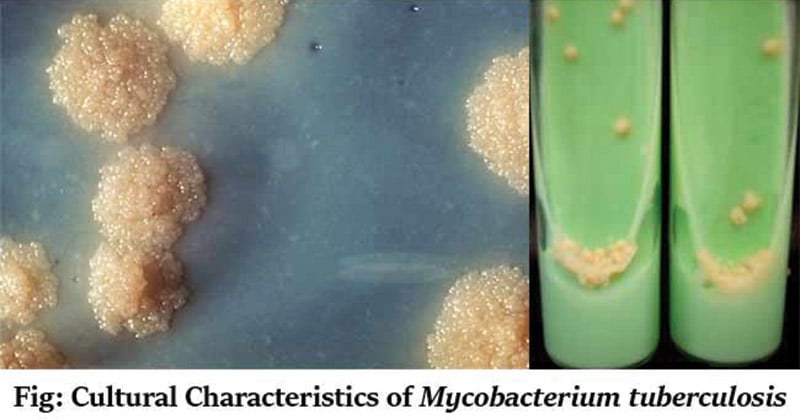Lowenstein Jensen (LJ) Media is a selective medium that is commonly used for the cultivation and isolation of Mycobacterium, specifically Mycobacterium tuberculosis from clinical specimens. LJ medium was originally formulated by Lowenstein who incorporated congo red and malachite green to inhibit unwanted bacteria. The present formulation comprises a glycerated egg-based medium and is based upon Jensen’s modification. Jensen modified Lowenstein’s medium by altering the citrate and phosphate contents, eliminating the congo red dye, and by increasing the malachite green concentration. Gruft further modified L. J. Medium with the addition of penicillin, nalidixic acid, and ribonucleic acid (RNA) to increase selectivity. This medium supports the growth of a wide variety of Mycobacteria and can also be used for niacin testing.
Interesting Science Videos
Composition of Lowenstein Jensen (LJ) Media
| Ingredients | Amount |
| Potato Flour | 30.0gm |
| L- Asparagine | 3.6gm |
| Monopotassium Phosphate | 2.4gm |
| Magnesium Citrate | 0.6gm |
| Malachite Green | 0.4gm |
| Magnesium Sulfate | 0.24gm |
| Glycerol | 12ml |
| Egg Base | 1000ml |
Lowenstein Jensen, Gruft Modification is the same as LJ Medium with the addition of:
| Nalidixic acid | 56.0mg |
| Penicillin | 52.8mg |
| RNA | 0.05mg |
Principle of Lowenstein Jensen (LJ) Media
L-Asparagine and Potato Flour are sources of nitrogen and vitamins. Monopotassium Phosphate and Magnesium Sulfate enhance organism growth and act as buffers. Malachite green prevents the growth of the majority of contaminants surviving decontamination of the specimen while encouraging the growth of Mycobacteria. Egg Suspension provides fatty acids and protein required for the metabolism of Mycobacteria. When heated, the egg albumin coagulates, thus providing a solid surface for inoculation. Glycerol serves as a carbon source and is favorable to the growth of the human-type tubercle bacillus while being unfavorable to the bovine type.
In the Gruft method, Penicillin and Nalidixic acid along with malachite green prevent the growth of the majority of contaminants surviving decontamination of the specimen while encouraging the earliest possible growth of Mycobacteria. RNA acts as a stimulant and helps to increase the isolation rate of Mycobacteria.
Preparation of Lowenstein Jensen (LJ) Media
- Dissolve 37.3 g of the medium in 600 mL of purified water containing 12 mL of glycerol.
- Heat with frequent agitation to completely dissolve the medium.
- Autoclave at 121°C for 15 minutes.
- Prepare 1000 mL of a uniform suspension of fresh eggs under aseptic conditions. Avoid whipping air into suspension during the collection and mixing.
- Aseptically mix the 1000 mL of egg suspension with 600 mL of the sterile Lowenstein-Jensen Medium cooled to 50 – 60°C, avoiding air bubbles.
- Dispense the finished medium into sterile screw-cap test tubes. Place the tubes in a slanted position and heat at 85°C for 45 minutes.
Result Interpretation of Lowenstein Jensen (LJ) Media

- Cultures should be read within 5 to 7 days after inoculation and once a week thereafter for up to 8 weeks.
- The typical colonies are non pigmented, rough, dry on LJ medium.
- The green color of the medium is due to the presence of malachite green which is one of the selective agents to prevent growth of most other contaminants.
- Rapid growers have mature colonies within 7 days; slow growers require more than 7 days for mature colony forms.
- Pigment production:
- White, cream or buff = Nonchromogenic (NC)
- Lemon, yellow, orange, red = Chromogenic (Ch)
Uses of Lowenstein Jensen (LJ) Media
- It is used for the diagnosis of Mycobacterial infections.
- It is used for testing antibiotic susceptibility of isolates.
- It is also used for differentiating different species of mycobacterium (by colony morphology, growth rate, biochemical characteristics and microscopy).
Limitations of Lowenstein Jensen (LJ) Media
- It is recommended that biochemical and/or serological tests be performed on colonies from pure culture for complete identification.
- LJ Media require incubation in a 5-10% CO2 atmosphere in order to recover Mycobacteria. Mycobacteria, for unknown reasons, are not recovered well from candle extinction jars.
- Negative culture results do not rule-out active infection by mycobacteria.
- Due to nutritional variation, some strains may be encountered that grow poorly or fail to grow on this medium. Further tests are necessary for confirmation of Mycobacterium spp.
- The media should be protected from all sources of light, as malachite green is very photosensitive.
References
- https://en.wikipedia.org/wiki/L%C3%B6wenstein%E2%80%93Jensen_medium
- http://himedialabs.com/td/m162.pdf
- https://microbeonline.com/preparation-uses-lowenstein-jensen-lj-medium/
- https://laboratoryinfo.com/lj-medium/
- http://legacy.bd.com/ds/technicalCenter/inserts/8011670(02).pdf
- Naveen, G., & Peerapur, B. V. (2012). Comparison of the Lowenstein-Jensen Medium, the Middlebrook 7H10 Medium and MB/BacT for the Isolation of Mycobacterium Tuberculosis (MTB) from Clinical Specimens. Journal of Clinical and Diagnostic Research : JCDR, 6(10), 1704–1709. http://doi.org/10.7860/JCDR/2012/4603.2635

I’m confused about the expiry date of LJ egg base medium.
Please may I have the right expiry date?
Good Article to read. Thanks.